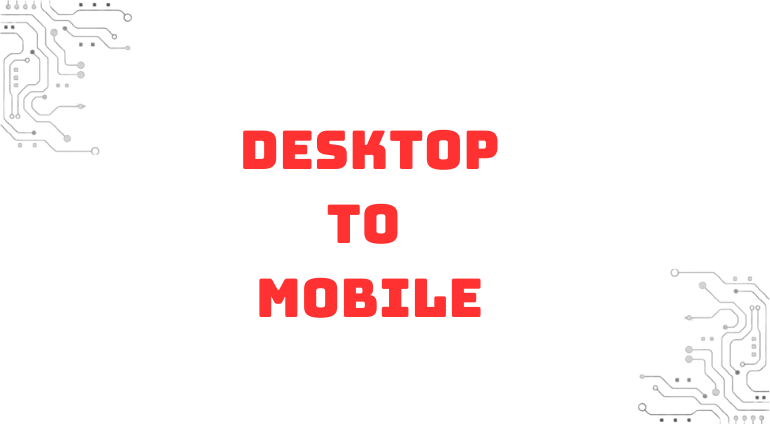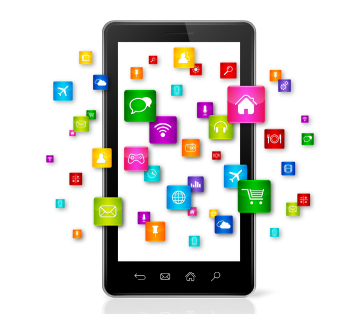
In the rapidly evolving digital landscape, transitioning from a desktop application to a mobile application offers significant advantages. This shift is particularly beneficial for businesses aiming to enhance their operational efficiency, customer engagement, and market reach. Here’s a look at the key benefits and the types of businesses that stand to gain the most from this digital transformation.
1. Enhanced Accessibility and Convenience: Mobile applications provide users with the convenience of accessing
services anytime and anywhere. This level of accessibility is unmatched by desktop applications, which require a
stationary setup. Mobile apps cater to the on-the-go lifestyle of modern consumers, thereby increasing user
engagement and satisfaction.
2. Improved User Experience: Mobile applications are designed with touch interfaces and intuitive navigation,
making them user-friendly. The streamlined experience can lead to higher user retention and increased usage frequency
compared to traditional desktop applications.
3. Greater Reach and Market Penetration: Mobile apps have the potential to reach a broader audience. With the
proliferation of smartphones, businesses can tap into a vast market that may not have regular access to desktop computers.
This expanded reach can drive growth and open up new revenue streams.
4. Real-Time Communication and Updates: Mobile applications can offer real-time notifications and updates,
keeping users informed and engaged. This instant communication is crucial for businesses that rely on timely information
dissemination, such as news outlets, financial services, and e-commerce platforms.
5. Integration with Mobile Device Features: Mobile apps can leverage built-in features of smartphones,
such as GPS, camera, and accelerometer, to offer innovative services that desktop applications cannot.
For example, location-based services, augmented reality experiences, and mobile payments enhance the functionality
and value of the app.
6. Increased Customer Engagement and Loyalty: With features like push notifications, personalized content,
and in-app promotions, mobile apps can significantly enhance customer engagement. These features help businesses
build stronger relationships with their customers, fostering loyalty and repeat business.
Transitioning from a desktop application to a mobile application is a strategic move that can drive significant business benefits. By enhancing accessibility, improving user experience, and leveraging mobile-specific features, businesses can better meet the needs of modern consumers. Embracing mobile technology not only positions businesses for growth but also helps them stay competitive in today’s fast-paced digital world.

This is what you gain with your own mobile app:
A: Here are some key industries that can significantly benefit from transitioning to mobile applications:
1. Retail and E-Commerce: Mobile apps allow retailers to offer a seamless shopping experience, from browsing to payment.
Features like mobile wallets, personalized recommendations, and push notifications about sales and promotions can drive sales
and customer loyalty.
2. Financial Services: Banks and financial institutions can provide customers with secure, on-the-go access to their
accounts, transaction histories, and financial tools. Mobile banking apps enhance customer convenience and trust.
3. Healthcare: Medical providers can use mobile apps to offer telemedicine services, appointment scheduling, and
access to medical records. These apps improve patient engagement and streamline healthcare delivery.
4. Travel and Hospitality: Mobile apps can enhance the travel experience by offering booking services, itinerary
management, real-time updates, and location-based recommendations. These features make travel more convenient and
enjoyable for customers.
5. Media and Entertainment: Streaming services, news outlets, and gaming companies can reach a larger audience
through mobile apps. Features like offline access, personalized content, and interactive experiences keep users engaged
and entertained.
6. Education: Educational institutions and e-learning platforms can deliver courses, resources, and interactive
learning experiences via mobile apps. These apps support remote learning and provide students with flexible access to
educational content.
Transitioning from a desktop application to a mobile application is a strategic move that can drive significant business benefits. By enhancing accessibility, improving user experience, and leveraging mobile-specific features, businesses can better meet the needs of modern consumers. This digital transformation is particularly advantageous for industries where customer engagement and convenience are paramount. Embracing mobile technology not only positions businesses for growth but also helps them stay competitive in today’s fast-paced digital world.
A: In what organizational areas does mobile technology have the most positive impact when replacing desktop software through digital transformation?
1. Sales and Marketing: Mobile apps enable sales and marketing teams to access real-time customer data,
track leads, and manage campaigns on the go. Push notifications, personalized marketing, and mobile CRM integrations
enhance customer engagement and streamline sales processes.
2. Supply Chain Management: Mobile apps can optimize supply chain operations by providing real-time tracking of
shipments, inventory management, and supplier communication. This improves logistics efficiency, reduces delays,
and enhances overall supply chain visibility.
3. Field Service and Operations: Field technicians and operational staff can benefit from mobile apps by
accessing job details, updating work orders, and reporting issues in real-time. This increases operational efficiency,
reduces downtime, and enhances service delivery.
4. Finance and Accounting: Finance teams can manage budgets, track expenses, and approve invoices through mobile
applications. This enables faster decision-making, improves financial accuracy, and enhances overall financial management.
5. Human Resources: HR departments can use mobile apps for employee self-service, including time tracking, leave
management, and benefits enrollment. Mobile apps facilitate efficient HR processes and improve employee engagement
and satisfaction.
6. Project Management: Project managers can use mobile apps to track project progress, collaborate with team members,
and manage tasks from anywhere. This improves project visibility, coordination, and on-time delivery.
7. Logistics:: Logistics teams can leverage mobile apps to manage real-time tracking of shipments, optimize routing,
and handle logistics coordination. This leads to increased efficiency, reduced delivery times, and improved customer
satisfaction.
8. Warehousing:: Warehousing operations can benefit from mobile apps for inventory management, order processing,
and stock level monitoring. This ensures better accuracy, reduces errors, and enhances overall warehouse productivity.
9. Transportation:: Transportation departments can use mobile apps to monitor fleet status, track vehicle locations,
and manage driver assignments. This optimizes route planning, reduces fuel costs, and improves overall transportation efficiency.
10. Executive Leadership:: Executives and senior leaders can benefit from mobile apps by accessing real-time business
awareness, performance metrics, and strategic reports. This supports informed decision-making and agile leadership.
Investing in digital transformation to build a mobile application provides numerous benefits across various organizational roles and functions. From sales and marketing to supply chain management, field operations, human resources, finance, project management, executive leadership, logistics, warehousing, and transportation, mobile apps enhance accessibility, streamline processes, and improve overall efficiency. By transitioning from desktop software to mobile applications, organizations can position themselves for growth, innovation, and a competitive edge in the modern business landscape.
A: Transforming a desktop software application into a mobile app for Apple (iOS) and Android involves several key steps:
1. Assessment and Planning:
> Requirement Analysis: Evaluate the functionalities of the existing desktop application and determine which
features are essential for the mobile version.
> Target Audience and Platform Selection: Decide whether to develop for iOS, Android, or both, based on
your target audience.
> Technical Feasibility: Assess the technical feasibility of replicating desktop functionalities on mobile platforms.
2. Design and User Experience (UX):
> UI/UX Design: Create a mobile-friendly user interface that ensures an intuitive and seamless user experience.
Mobile app design principles differ significantly from desktop design, emphasizing simplicity and ease of navigation.
> Prototype Development: Develop prototypes to visualize the app’s layout and user flow.
3. Technology Stack Selection:
> Development Frameworks: Choose the appropriate frameworks and tools. For cross-platform development, frameworks
like Flutter or React Native can be used. Alternatively, native development can be done using Swift for iOS and
Kotlin/Java for Android.
4. Development:
> Backend Development: Adapt or create a backend infrastructure that supports mobile functionalities, including APIs
and databases.
> Frontend Development: Develop the mobile app’s frontend, ensuring compatibility with iOS and Android guidelines
and standards.
> Integration: Integrate essential features such as authentication, data synchronization, push notifications, and
offline capabilities.
5. Testing:
> Unit Testing: Test individual components and modules of the app.
> Integration Testing: Ensure all components work together seamlessly.
> User Acceptance Testing (UAT): Conduct testing with a group of end-users to gather feedback and make
necessary adjustments.
> Performance and Security Testing: Ensure the app performs well under different conditions and adheres to
security standards.
6. Deployment:
> App Store Submission: Prepare the app for submission to the Apple App Store and Google Play Store.
This involves adhering to each platform’s guidelines and creating the necessary marketing materials
(screenshots, descriptions, etc.).
> Approval and Launch: Submit the app for review and, once approved, launch it on the respective app stores.
7. Post-Launch Maintenance and Updates:
> Monitoring and Bug Fixes: Continuously monitor the app for any issues or bugs and release timely updates
to address them.
> Feature Enhancements: Based on user feedback and market trends, introduce new features and improvements
to keep the app relevant and competitive.
By following these steps, you can successfully transform a desktop software application into a robust and user-friendly mobile app, enhancing accessibility and user engagement across mobile platforms.